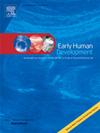Urinary biomarkers in neonates born to mothers with preeclampsia: A case-control study
IF 2.2
3区 医学
Q2 OBSTETRICS & GYNECOLOGY
引用次数: 0
Abstract
Background
Effects of preeclampsia (PE) on fetal renal development are unknown. We hypothesized that the circulating factors causing endothelial dysfunction and impaired renal function in mothers with PE adversely affect fetal kidneys.
Objective
To compare urinary biomarkers in infants born to mothers with and without PE.
Methods
Sixty-eight mothers and their newborns with gestational age ≥ 32 weeks were enrolled. We collected bag urine samples from infants during the first 48 h of life. Urine samples were centrifuged at 1500 rpm for 10 min. Supernatant after excluding the bottom 1 mL of urine was stored at −70 °C until assayed. Urinary creatinine, protein, cystatin C, nephrin, kidney injury molecule – 1, and klotho were measured.
Results
Sixteen mothers in the PE group had severe features of PE. The PE group infants had lower body length compared to the control group (46.4 ± 3.4 vs 48.6 ± 3.4 cm; p = 0.007). Urine protein and creatinine were significantly higher in the PE group infants [protein 37.1 (14.4, 53.5) vs 20.3 (7.5, 30.0) mg/dl, p = 0.04; creatinine 63.4 (25.2, 96.6) vs 24.8 (19.8, 44.2) mg/dl, p = 0.008]. There were no statistically significant differences in the urinary concentrations of the remaining four biomarkers. The urinary protein, creatinine and nephrin concentrations had significant negative correlation with gestational age (p values 0.07, 0.0003 and 0.0008 respectively).
Conclusions
The findings of higher urinary protein and the observed trends in the levels of urinary nephrin and klotho are suggestive of glomerular immaturity and/or impaired function in infants born to mothers with PE.
子痫前期母亲所生新生儿尿液生物标志物:一项病例对照研究
背景:子痫前期(PE)对胎儿肾脏发育的影响尚不清楚。我们假设导致PE母亲内皮功能障碍和肾功能受损的循环因素对胎儿肾脏有不利影响。目的:比较有和无PE母亲所生婴儿的尿液生物标志物。方法:68名孕周≥32周的母亲及其新生儿。我们收集了婴儿出生后48小时的袋尿样本。尿液样本在1500 rpm下离心10分钟。除去底部1ml尿液后的上清在-70°C下保存直至检测。测定尿肌酐、蛋白、胱抑素C、肾素、肾损伤分子- 1、klotho。结果:PE组有16例母亲有严重的PE特征。与对照组相比,PE组婴儿的下体长(46.4±3.4 vs 48.6±3.4 cm);p = 0.007)。PE组婴儿的尿蛋白和肌酐显著高于对照组[蛋白37.1 (14.4,53.5)vs 20.3 (7.5, 30.0) mg/dl, p = 0.04;肌酐63.4 (25.2,96.6)vs 24.8 (19.8, 44.2) mg/dl, p = 0.008]。其余四种生物标志物的尿液浓度没有统计学上的显著差异。尿蛋白、肌酐、肾素浓度与胎龄呈显著负相关(p值分别为0.07、0.0003、0.0008)。结论:尿蛋白升高以及尿肾素和klotho水平变化趋势提示PE母亲所生婴儿肾小球发育不成熟和/或功能受损。
本文章由计算机程序翻译,如有差异,请以英文原文为准。
求助全文
约1分钟内获得全文
求助全文
来源期刊

Early human development
医学-妇产科学
CiteScore
4.40
自引率
4.00%
发文量
100
审稿时长
46 days
期刊介绍:
Established as an authoritative, highly cited voice on early human development, Early Human Development provides a unique opportunity for researchers and clinicians to bridge the communication gap between disciplines. Creating a forum for the productive exchange of ideas concerning early human growth and development, the journal publishes original research and clinical papers with particular emphasis on the continuum between fetal life and the perinatal period; aspects of postnatal growth influenced by early events; and the safeguarding of the quality of human survival.
The first comprehensive and interdisciplinary journal in this area of growing importance, Early Human Development offers pertinent contributions to the following subject areas:
Fetology; perinatology; pediatrics; growth and development; obstetrics; reproduction and fertility; epidemiology; behavioural sciences; nutrition and metabolism; teratology; neurology; brain biology; developmental psychology and screening.
 求助内容:
求助内容: 应助结果提醒方式:
应助结果提醒方式:


